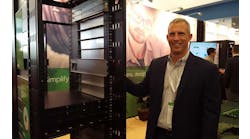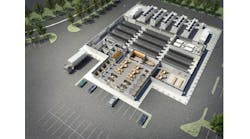IoT Drives Demand for Data Centers
CHRIS CROSBY, CEO, Compass Datacenters
In this edition of “Voices of the Industry” Chris Crosby, CEO of Compass Datacenters shares his excitement on the impact of technologies like Internet of Things (IOT) and rich media content which are impacting the demand, designs and location for datacenters.
IDC recently published a report saying that the need for data center capacity will grow by 750% over the next four years. Since we’re in the data center business here at Compass, we’re positively giddy with excitement and are currently adding more phone lines to handle the expected increase in call volume. Let’s be honest with ourselves, you don’t see growth rates like that for pretty much anything, and that includes those home shopping channels that will double your order for free “if you act now”. I think we all know how compelling those are. I myself have fallen victim to their allure in my efforts to expand my chamois collection. Anyway, the major driver of this geometric increase in the need for more data center space, according to IDC, is the continued growth of the Internet of Things (IOT). I couldn’t agree more, but I think we’ll see additional ramifications from the IOT’s attempt to redefine ubiquity that will impact all of us.
For those of you out there excited about the prospect of being able to track the location of your TV’s remote control, or the amount of beer you have left in the refrigerator, I urge you to think a little bigger—although both of these capabilities are pretty darn exciting.
First, data centers themselves are going to have to change. In the realm of the IOT, billions of small packets of information from billions of devices will have to be processed. Today, that same scenario is know as a Denial of Service (DOS) attack and brings fat pipe networks down to a trickle of bits. —Additionally, with IOT, value in most cases is only derived from near real-time processiong on a continuous basis for the information. For example, theft prevention in a retail store only works in real-time, otherwise it is called “forensics” by the police. To hit a bit closer to home, if your beer inventory isn’t quickly updated, your wife could slip in and grab the last one thereby leaving you with a bowl of pretzels in your lap, the big game on TV, drinking a can of Fresca—that stuff is nasty. Incidents like this can lead to disturbances in domestic tranquility, and their avoidance is one of the IOT’s major benefits. Obviously, this is really going to put the “critical” in “mission critical” and require that facilities be built to ensure uptime, thereby making concurrent reliability a de facto requirement in most cases.
On the other end of the spectrum is the need to keep information as close to the end user as possible due to the need for a low latency, positive user experience. In a world where your 11-year old is savvy enough to look for another content source if they see an hourglass icon, housing compute and storage in a single location with a higher latency connection isn’t going to get the job done. You see the huge packet, high quality of service for items like the latest Avengers movie download is a completely different problem to solve on the network versus the IOT of billions of tiny packets from billions of devices. The one thing that is true for both IOT and rich content is that the network gets creamed in either case.
Chris Crosby is the CEO of Compass Datacenters.





